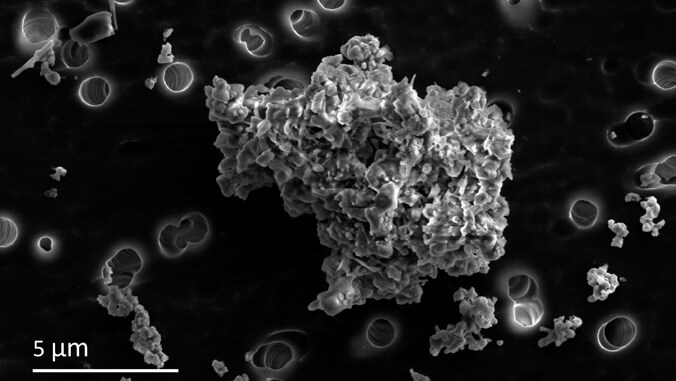A team of scientists led by University of Hawaiʻi at Mānoa School of Ocean and Earth Science and Technology (SOEST) researcher Hope Ishii has discovered that certain interplanetary dust particles (IDPs) contain dust leftover from the initial formation of the solar system.
The initial solids from which the solar system formed consisted almost entirely of amorphous silicate, carbon and ices. This dust was mostly destroyed and reworked by processes that led to the formation of planets. Surviving samples of pre-solar dust are most likely to be preserved in comets—small, cold bodies that formed in the outer solar nebula.
In a relatively obscure class of IDPs believed to originate from comets, there are tiny glassy grains called GEMS, or glass embedded with metal and sulfides—typically only tens to hundreds of nanometers in diameter, less than 1/100th the thickness of human hair.
Building blocks of planets and stars
Using transmission electron microscopy, Ishii and colleagues made maps of the element distributions and discovered that these glassy grains are made up of subgrains that aggregated together in a different environment and prior to the formation of the comet parent body. This aggregate is encapsulated by carbon of a different type than the carbon that forms a matrix gluing together GEMS and other components of cometary dust.
The types of carbon that rims the subgrains and that forms the matrix in these particles decomposes with even weak heating, suggesting that the GEMS could not have formed in the hot inner solar nebula, and instead formed in a cold, radiation-rich environment, such as the outer solar nebula or pre-solar molecular cloud.
“Our observations suggest that these exotic grains represent surviving pre-solar interstellar dust that formed the very building blocks of planets and stars,” said Ishii, who is based at the UH Mānoa Hawaiʻi Institute of Geophysics and Planetology. “If we have at our fingertips the starting materials of planet formation from 4.6 billion years ago, that is thrilling and makes possible a deeper understanding of the processes that formed and have since altered them.”
Excellence in space science at UH
UH has a strong footprint in space science and state-of-the-art instrumentation and is recognized as world-class in this field.
“This is an example of research that seeks to satisfy the human urge to understand our world’s origins and serves the people of Hawaiʻi by boosting our reputation for excellence in space science and as a training ground for our students to be engaged in exciting science,” said Ishii.
The team plans to search the interiors of additional comet dust particles, especially those that were well-protected during their passage through the Earth’s atmosphere, to increase understanding of the distribution of carbon within GEMS and the size distributions of GEMS subgrains.
Funding and collaboration
This work was funded by NASA’s Cosmochemistry, Emerging Worlds and Laboratory Analysis of Returned Samples Programs and was enabled, in part, by the Advanced Electron Microscopy Center at UH. Portions of the work were also performed at national user facilities at the Molecular Foundry and the Advanced Light Sourceat Lawrence Berkeley National Laboratory, which are supported by the Office of Science, Basic Energy Sciences, U.S. Department of Energy.
If our reporting has informed or inspired you, please consider making a donation. Every contribution, no matter the size, empowers us to continue delivering accurate, engaging, and trustworthy science and medical news. Independent journalism requires time, effort, and resources—your support ensures we can keep uncovering the stories that matter most to you.
Join us in making knowledge accessible and impactful. Thank you for standing with us!

